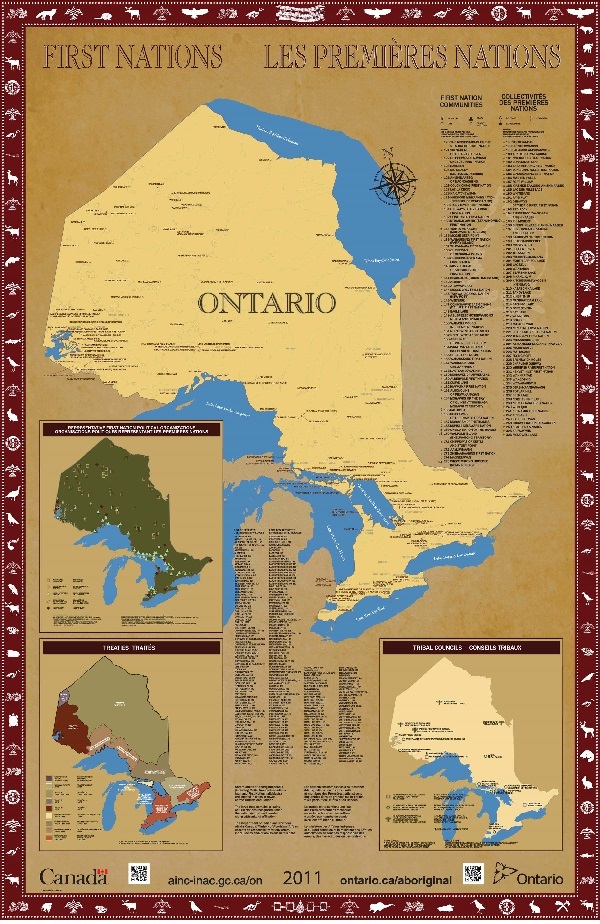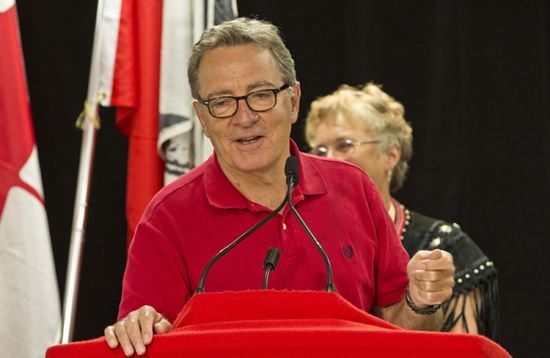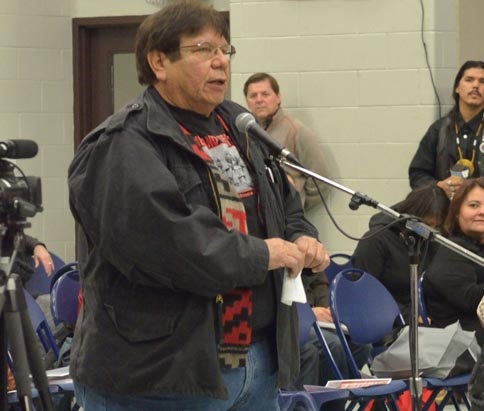
Ontario will help provide our students with greater knowledge and a stronger
appreciation of contemporary and traditional First Nation traditions, cultures, and
perspectives.”
Liz Sandals
Minister of Education
Ontario is sending a First Nations and Treaties map to every elementary and high school in the province as a first step towards raising awareness about treaties. The map will help teach students about the significance of treaties and the shared history of First Nations and non-Aboriginal Ontarians.
In partnership with First Nation leaders, new school curriculum about treaties is being developed to give students a better understanding of First Nation communities, cultures and perspectives. Ontario will also be working with First Nation partners to look for other opportunities to raise awareness and to better understand different perspectives on treaties and related issues.
Working with First Nations is part of the government’s plan that is creating jobs for today and tomorrow and focuses on Ontario’s greatest strengths — its people and strategic partnerships.
Quick Facts
A treaty is a negotiated agreement that sets out the rights, responsibilities and relationships of Aboriginal people and the Crown, including the federal and provincial governments.
First Nations and Treaties is the first detailed map of treaties that the Ontario government has published since the 1940s.
Prior to contact with Europeans, First Nations were distinct, independent nations. The treaties they made with the Crown reflect a mutual commitment to working together on areas of common interest and mutual benefit.
Ontario is covered by 46 treaties and other agreements such as land purchases by the Crown signed between 1781 and 1930.
Quotes

“Treaties are the foundation of the relationship between First Nation communities
and their neighbours. By working together, we are able to better understand one
another – our views, our beliefs, and the treaties without which our province would
not exist.” David Zimmer Minister of Aboriginal Affairs
“The treaty maps and related curriculum materials distributed in our schools across
Ontario will help provide our students with greater knowledge and a stronger
appreciation of contemporary and traditional First Nation traditions, cultures, and
perspectives.” Liz Sandals Minister of Education
“In the Report of the Ipperwash Inquiry I noted that one initiative on which virtually everyone agreed was the importance of teaching Ontarians about treaties and Aboriginal people. This treaties map and the Ontario curriculum introduced since the Inquiry are important steps on the road to reconciliation and wider recognition that we are all treaty people.” The Honourable Sidney B. Linden Commissioner

“The province of Ontario exists as it does because First Nations and settlers made treaties in the past. Those treaties remain vital agreements today. A better understanding of those treaties through education, public awareness and discussion is fundamental to a more prosperous tomorrow for all Ontarians.” Chief Tom Bressette Chippewas of Kettle and Stony Point First Nation
Supplemental- View full size map on your device.
Caledonia: We can learn from precedents that have been set
On February 28, 2006, as MPPs began to assemble at Queen’s Park for afternoon
Question Period, I was alerted by a colleague that construction workers were being
driven out of a subdivision in my riding, in Caledonia.
As a Member of the Opposition, I crossed the floor and sat down with then-Minister
of Natural Resources, David Ramsay, who had responsibility for Aboriginal Affairs.
Given the seriousness of this very recent development, and because we both wanted to
know who was in charge, we went through his briefing books together. At every turn,
the advice indicated—’this matter is federal’.
The next morning, I drove down to Caledonia and walked back into the Douglas Creek
Estates subdivision to find out what was going on and who was in charge. I
explained I was MPP for both Caledonia and Six Nations but was ignored, other than
being invited to come to the fire to keep warm. After a few hours one of the
organizers explained they could not talk to me—’this matter is federal’.
Over the ensuing weeks, I continued to walk into the subdivision many times. And, as
communication and trust developed, I served as a bit of a liaison with the police,
talked to clan mothers and most of the players, and at one point drove to Ottawa to
present their case to the Office of the Governor General.
These efforts pretty well ground to a halt after an aborted police raid on April 20,
2006 and the subsequent purchase of the subdivision by the McGuinty government.
But what then happened was unprecedented. In spite of a Cayuga court ruling by
Justice David Marshall, Premier McGuinty sent taxpayer-funded lawyers to essentially
legalize the militant occupation—basically arguing that since Mr. McGuinty welcomed
the occupiers, there should be no injunction against their presence.
On August 8, 2006, the province appealed Justice Marshall’s judgement ordering the
Attorney General to take carriage of the ongoing contempt of court, and to report
back at a later date.
In court on August 22, government lawyers argued that Justice Marshall’s orders
should be set aside until the fall appeal could be heard. They pointed out that the
province does not wish to remove the protestors from the occupied site, and
therefore, does not believe the protestors are breaking the law.
At that point, we had a government in Ontario that had found a way to tacitly signal
its willingness to tolerate suspensions of the rule of law. Justice Marshall warned
at the time, “If court orders can be disregarded, the whole fabric of democracy
falls to pieces.”
When the previous government signaled its willingness to look the other way while
laws were being broken, it raised concerns. In 2006, people were watching, coast to
coast, and were critical.
The Vancouver Sun reported at the time that the “…Liberal government is more
concerned with political sensitivities then with upholding the law.” The Nanaimo
Daily News labelled “McGuinty’s Caledonia gambit a catastrophe,” and the Winnipeg
Free Press lamented, “The OPP, in fact, has been standing by since April, apparently
on the instructions of Premier Dalton McGuinty’s Liberal government.”
We can learn from the past. Precedents were set and locked in place over the past
14 years. We now have provincial leadership that realizes it’s time for a change.
Toby Barrett MPP for Haldimand-Norfolk